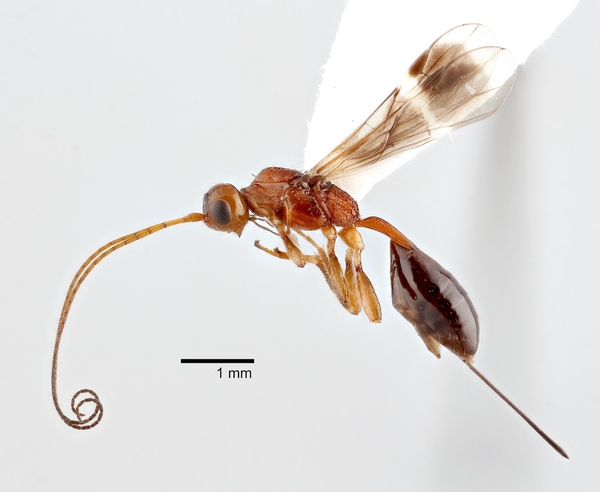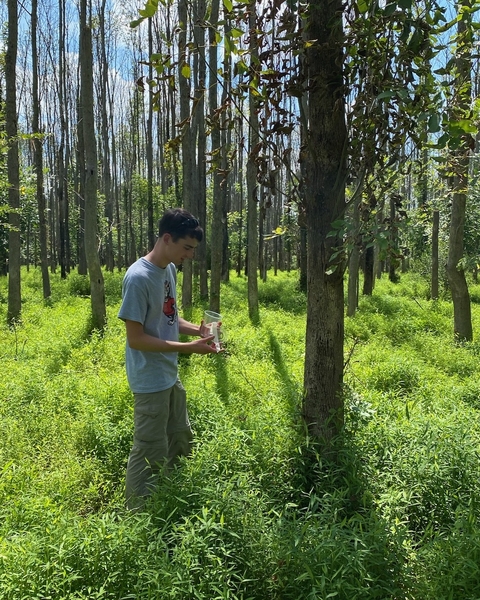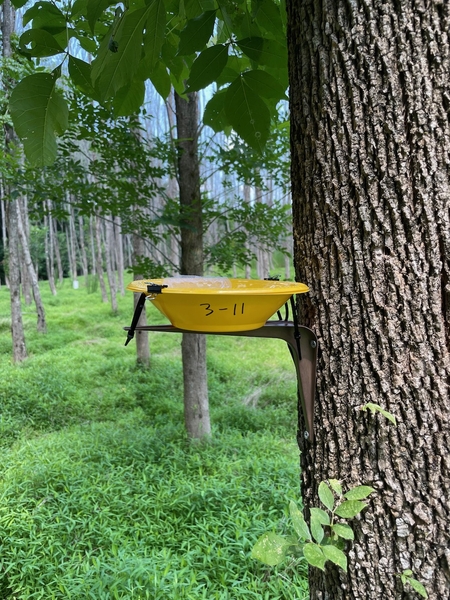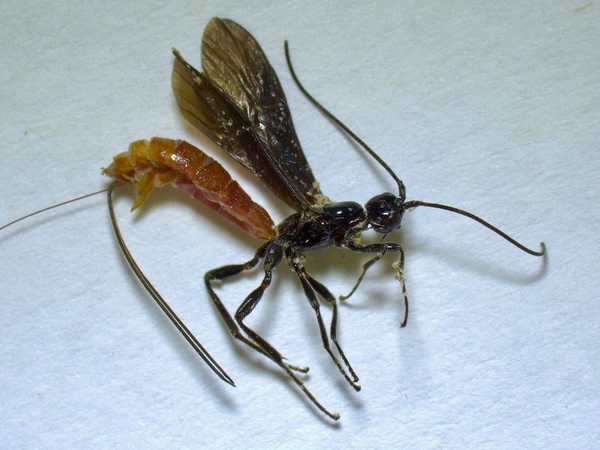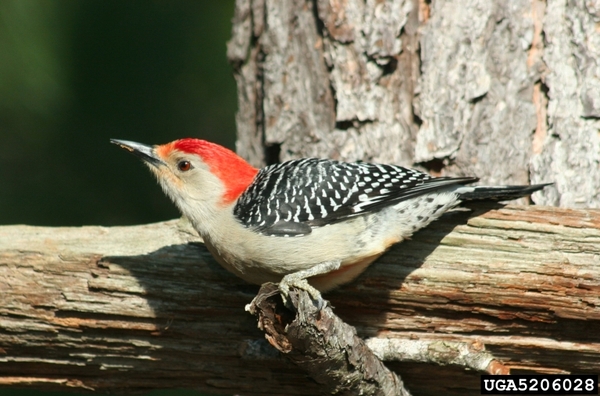Introduction
One of the most destructive non-native pests to impact forests in North Carolina is the emerald ash borer (EAB; Agrilus planipennis). This insect is a small, metallic green beetle that was accidentally introduced to North America from its native range in northeastern Asia, likely in wood packaging material. First detected in the U.S. near Detroit, Michigan in 2002, EAB has spread across eastern North America and was first detected in North Carolina in 2013. Adult EAB lay their eggs on ash trees such as green ash (Fraxinus pennsylvanica) and white ash (Fraxinus americana). After hatching, the EAB larvae (immature stage) bore under the bark and create S-shaped tunnels called “galleries” as they feed in the inner bark and outer wood. These galleries are one way to identify EAB damage. This damage cuts off the flow of nutrients and water within the tree, typically causing the tree to die within five years of infestation.
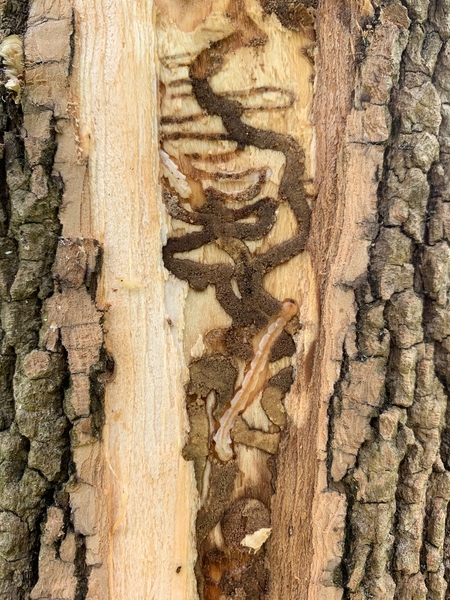
Emerald ash borer larvae under the bark of an ash tree.
Ryan Bohannon, NC State University CC BY 4.0
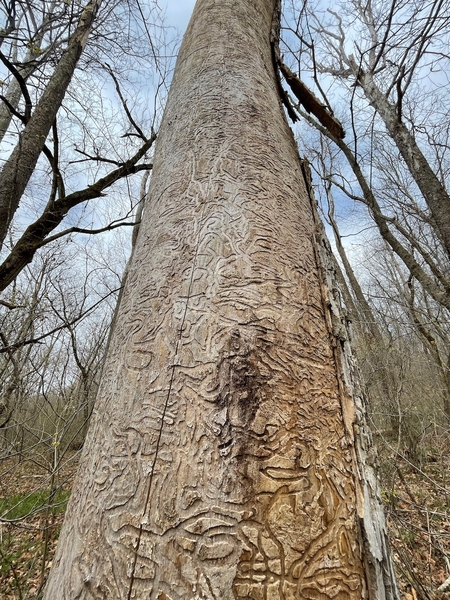
Galleries made by emerald ash borer larvae on an ash tree.
Ryan Bohannon, NC State University CC BY 4.0

Green ash trees that have been killed by emerald ash borer.
Ryan Bohannon, NC State University CC BY 4.0
Emerald Ash Borer Management
Management of EAB in North American forests is challenging. Preventing the movement of EAB-infested plant material, especially firewood, can help limit EAB's spread, but federal quarantines were lifted in January 2021. Individual, high-value ash trees can be protected using insecticide treatments, but this is not practical across forested landscapes due to high costs, logistics, and potential environmental concerns. As a result, a sustainable approach is needed to manage EAB in forests. Ongoing research is working to identify and breed ash trees that may possess resistance to EAB, but resistant North American ash trees are not yet available.
Biological Control of Emerald Ash Borer
Currently, the leading strategy for managing EAB in forests is biological control (also called “biocontrol”). Biological control programs involve controlling pest populations by using natural enemies that attack it. The EAB biological control program uses classical biological control which involves the importation, release, and establishment of natural enemies that attack a non-native pest in its native range and help suppress its numbers below a damaging level. Classical biological control is an attractive management option for invasive forest pests like EAB because if released natural enemies become established, they can spread naturally across the landscape and could provide sustainable control of the target pest without the need for continuous input from managers.
The EAB biological control program in the United States is operated by the United States Department of Agriculture Animal and Plant Health Inspection Services (USDA-APHIS). The natural enemies used in this program are small parasitoid wasps that attack EAB in its native range in Asia. These parasitoid wasps are insects that lay their eggs either in or on the eggs or larvae of EAB. The wasp larvae that hatch from these eggs then feed on or inside the EAB eggs or larvae as they develop, and they kill the EAB in the process. Before they were approved for release in the United States, these wasps were tested to determine that they would not negatively impact populations of insects other than EAB. These wasps are harmless to people.
Four species of wasps have been released for EAB biological control in the United States. Oobius agrili lays its eggs inside the eggs of EAB. The other three wasp species attack EAB larvae under the bark of ash trees. Spathius agrili and Spathius galinae paralyze EAB larvae and lay their eggs on the outside of the EAB larvae. Tetrastichus planipennisi lays its eggs inside of EAB larvae.
Biological Control Efforts in North Carolina
Parasitoid wasp releases began in North Carolina in 2013, the same year EAB was first detected in the state. All four wasp species have been released in North Carolina, and releases have been conducted by the NC Forest Service, NC State University, Virginia Tech, and other cooperators. These wasps are not currently available to private landowners. More than 90,000 wasps have been released at sites in the Piedmont and the inland extent of the Coastal Plain. Wasps have also been released in the neighboring states of Tennessee and Virginia, including in the Appalachian Mountains near the North Carolina state line.
In order for the EAB biological control program to be successful, the released wasps must be able to survive and persist in the environment over time. Current research at NC State is studying previous release sites in North Carolina to see whether the wasp species that were released have successfully established and are still present at these sites. While these released parasitoid wasps have successfully established in the northern United States, establishment of the wasps has been difficult in North Carolina.
This difficulty in getting wasps to establish may be due to a mismatch between the timing of wasp releases and the timing of the EAB life cycle in the warmer climate of North Carolina. Because the wasps only lay their eggs on certain life stages of EAB, wasp releases must be timed so those stages are present. NC State researchers studying the EAB life cycle in central North Carolina found EAB develops more rapidly than in the northern United States, likely due to the warmer temperatures the insects experience. Nearly all EAB studied in North Carolina completed their life cycle in one year, while many EAB further north take two years to develop from egg to adult. This faster development changes the timing of when EAB stages that can be attacked by the wasps are present. Understanding the EAB life cycle in North Carolina will help improve the timing of wasp releases to match the seasonal availability of appropriate EAB life stages in the state. This research will also help managers select the wasp species that are best suited to the EAB life cycle here. The wasp Spathius agrili originates from the southern portion of the native range of EAB, and EAB has a one-year life cycle in this region of Asia. For this reason, Spathius agrili may be well suited for attacking EAB in North Carolina and elsewhere in the Southeast.
Native Natural Enemies in North Carolina
In addition to the introduced wasps, there are natural enemies native to North Carolina that attack EAB. The most prominent native predators are woodpeckers that excavate EAB from under the bark of ash trees. Red-bellied woodpeckers are often observed foraging on EAB-infested ash trees in the North Carolina Piedmont. Native species of parasitoid wasps also will attack EAB. Common native parasitoid wasps found in stands of EAB-infested ash in North Carolina are Atanycolus species that attack EAB larvae. Unlike the introduced wasps, native natural enemies do not specifically target EAB and attack a variety of other insects that feed on ash trees. While native natural enemies can remove many EAB from infested trees, their impacts alone have not been enough to control EAB and prevent trees from being killed.
References
Gould, J. R., M. L. Warden, B. H. Slager, and T. C. Murphy. 2020. Host overwintering phenology and climate change influence the establishment of Tetrastichus planipennisi Yang (Hymenoptera: Eulophidae), a larval parasitoid introduced for biocontrol of the emerald ash borer. Journal of Economic Entomology 113: 2641–2649.
North Carolina Forest Service. n.d. Emerald ash borer frequently asked questions.
Oleniacz, L. 2020. Scientists pilot drones in effort to save tree from invasive beetle.
Publication date: May 31, 2022
N.C. Cooperative Extension prohibits discrimination and harassment regardless of age, color, disability, family and marital status, gender identity, national origin, political beliefs, race, religion, sex (including pregnancy), sexual orientation and veteran status.



